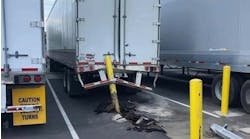The Federal Motor Carrier Safety Administration (FMCSA) is moving forward with a rule, originally proposed in 2016, to limit the speed of heavy-duty commercial vehicles, following recommendations from the National Roadway Safety Strategy (NRSS). The recently formed U.S. Department of Transportation (DOT) initiative identified speeding as a major factor in fatal crashes.
Meanwhile, two leading stakeholders in trucking chose to oppose each other again over the speed-limiter issue.
FMCSA's speed-limiter notice of intent (NOI) was published on April 27. If made into a final rule, the maximum speed of commercial vehicles—in excess of 26,000 lb. gross vehicle weight rating (GVWR) or gross vehicle weight (GVW), whichever is higher—involved in interstate commerce will be governed via their electronic engine control units (ECUs). The rule would cover Classes 7-8 commercial vehicles.
FMCSA has not identified what that maximum speed will be, but users will have “to maintain that ECU setting for the service life of the vehicle,” according to the agency's NOI.
A Supplemental Notice of Proposed Rulemaking (SNPRM) is expected to be published next year, and comments from the public will be considered when determining what the rule will ultimately mandate. This does not include previous comments made in 2016 concerning the initial proposal. FMCSA will field comments for 30 days following publication in the Federal Register, and those submitting comments should use docket No. FMCSA-2022-0004.
According to the National Highway Traffic Safety Administration (NHTSA), speeding in 2019 was a contributing factor in 26% of traffic fatalities. That year, more than 5,000 people were killed in large truck crashes (GVWR over 10,000 lb.), with 71% being occupants of the other vehicle, NHTSA found. One in five had at least one prior speeding conviction.
“The number of commercial motor vehicle crashes in which speed is listed as a contributing factor is unacceptable. A carrier-based approach could provide the opportunity to compel fleets that are not currently using speed limiters to slow down their CMVs within a relatively short period,” FMCSA asserted.
The NRSS was formed by DOT in January to address rising roadway fatalities and injuries. “We cannot tolerate the continuing crisis of roadway deaths in America. These deaths are preventable,” Transportation Secretary Pete Buttigieg said when the NRSS was launched.
DOT will focus on five areas to lower these accidents: safer people, safer roads, safer vehicles, safer speeds, and post-crash care. “Leveraging technology” will be one of the key initiatives, and the plan to govern speeds through commercial vehicle ECUs indicates that the agency Buttigieg leads is serious about reducing roadway incidents and fatalities.
Automatic emergency braking also was mentioned previously by the NRSS, so that onboard technology could be another tool identified in future regulations. Even if that is not the case, it’s unlikely DOT will slow its efforts to control fatalities on the road.
“Our goal is to prevent crashes and preserve the quality of life for all roadway users across America,” FMCSA Executive Director and Chief Safety Officer Jack Van Steenburg said. “Zero is our goal.”
ATA, OOIDA battle over speed limiters
Two industry stakeholder organizations that sometimes oppose each other are forcefully doing so again—this time over speed limiters.
American Trucking Associations (ATA), which generally represents larger U.S. carriers, came out in favor of FMCSA’s proposed rulemaking.
“ATA is pleased that the Federal Motor Carrier Safety Administration is pursuing a constructive, data-driven approach to the issue of truck speed limiters in its latest proposal,” ATA President and CEO Chris Spear said in a April 27 statement from the trucking federation.
“We intend to thoroughly review FMCSA’s proposal, and we look forward to working with the agency to shape a final rule that is consistent with our policy supporting the use of speed limiters in conjunction with numerous other safety technologies.”
The Owner-Operator Independent Drivers Association (OOIDA), which represents independent operators and smaller carriers, criticized the FMCSA announcement that the agency again was proceeding with a speed-limiter rule.
An April 28 OOIDA statement went on to say that policies and devices that limit speeds for large trucks create unnecessary congestion and dangerous speed differentials among vehicles, which lead to higher accident involvement rates.
“Studies and research have already proven what we were all taught long ago in driver’s ed classes, that traffic is safest when vehicles all travel at the same relative speed,” OOIDA President Todd Spencer said in the statement. “Limiting trucks to speeds below the flow of traffic increases interactions between vehicles, which can lead to more crashes.”
Additionally, the OOIDA statement noted, most crashes involving commercial vehicles occur in areas with speed limits below 55 mph, mitigating the effect of any potential mandate. “What the motoring public should know is that when they are stuck behind trucks on long stretches of highway, those trucks are often limited to a speed well under the posted speed limit,” Spencer added.




